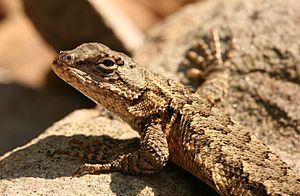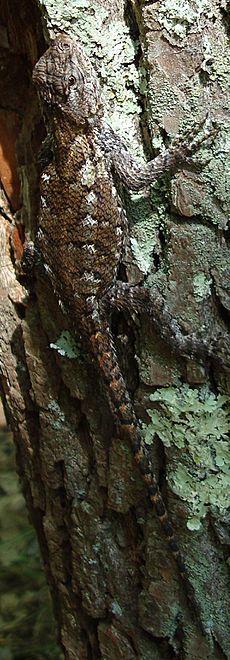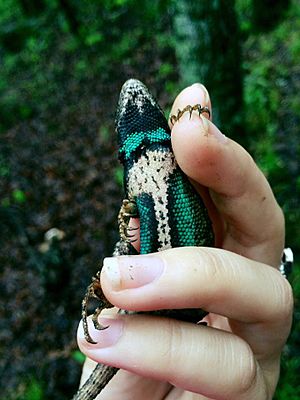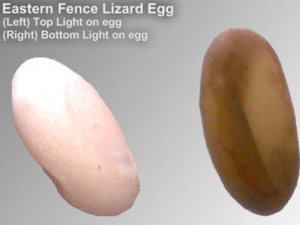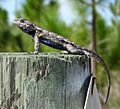Eastern fence lizard facts for kids
Quick facts for kids Eastern fence lizard |
|
|---|---|
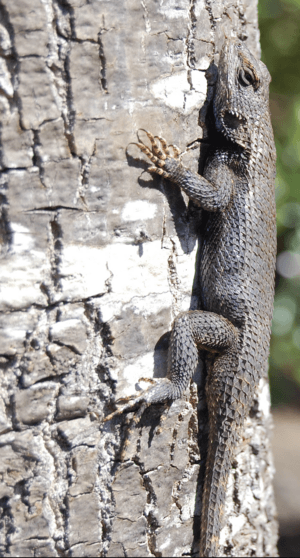 |
|
| Eastern fence lizard (Sceloporus undulatus), Amelia Court House, VA | |
| Conservation status | |
| Scientific classification | |
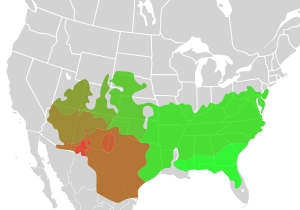 |
|
| The ranges of different S. undulatus subspecies are indicated by color. (note:map is missing distribution in New York State) | |
| Synonyms | |
|
The eastern fence lizard (Sceloporus undulatus) is a medium-sized species of lizard in the family Phrynosomatidae. The species is found along forest edges, rock piles, and rotting logs or stumps in the eastern United States. It is sometimes referred to as the prairie lizard, fence swift, gray lizard, northern fence lizard or pine lizard. It is also referred to colloquially as the horn-billed lizard.
Contents
Taxonomy
The generic name, Sceloporus, is derived from the Greek skelos/σκελος, meaning "leg", and the Latin porus, meaning "hole", referring to the enlarged femoral pores found in this genus of lizards. The specific name, undulatus, is Latin for "wave", referring to the transverse dark crossbars on the backs of these lizards.
Until 2002, 10 subspecies of S. undulatus were recognized, but re-evaluation showed paraphyly between the subspecies. These were reclassified as four distinct evolutionary species (the three new species being S. consobrinus, S. tristichus, and S. cowlesi). The narrowed redefinition of S. undulatus has been suggested to still contain two subspecies divided by the Appalachian Mountains. None is currently formally recognized.
The following cladogram is based on Leaché and Reeder, 2002:
|
|||||||||||||||||||||||||||||||||||||||||||
Distribution
The eastern fence lizard is found in Florida, Alabama, Louisiana, Arkansas, Colorado, Georgia, North Carolina, South Carolina, West Virginia, Virginia, Kentucky, Southern Illinois, Southern Indiana, Tennessee, Ohio, Pennsylvania, Maryland, Missouri, Mississippi, Delaware, northern Florida, southern Wyoming, southern New Jersey, and southeastern New York.
Description
The eastern fence lizard can grow from 4.0 to 7.5 inches (10 to 19 cm) in total length (including tail). It is typically colored in shades of gray or brown, and has keeled scales, with a dark line running along the rear of the thigh. A female is usually gray and has a series of dark, wavy lines across her back. The belly is white with black flecks, with some pale blue on the throat and belly. The male is usually brown, and during the summer, has a more greenish-blue and black coloration on the sides of the belly and throat than the female. The young look like the females, but are darker and duller.
They closely resemble the western fence lizard, but differ slightly in coloration and live in a different area and habitat.
Mating
Eastern fence lizards mate in spring, and lay 3 to 16 eggs in late spring or early summer. The young hatch in summer and fall. Male fence lizards often do "push-ups" to attract mates and to warn other males encroaching on their territory.
- Species Sceloporus undulatus at The Reptile Database
- Behler, John L.; King, F. Wayne (1979). The Audubon Society Field Guide to North American Reptiles and Amphibians. New York: Alfred A. Knopf. 743 pp., 657 color plates. ISBN: 0-394-50824-6. (Sceloporus undulatus, pp. 529–530 + Plate 375).
- Powell R, Conant R, Collins JT (2016). Peterson Field Guide to Reptiles and Amphibians of Eastern and Central North America, Fourth Edition. Boston and New York: Houghton Mifflin Harcourt. xiv + 494 pp., 47 Plates, 207 Figures. ISBN: 978-0-544-12997-9. (Sceloporus undulatus, p. 298 + Plate 27 + Map on p. 294).
- Smith, Hobart M.; Brodie, Edmund D., Jr. (1982). Reptiles of North America: A Guide to Field Identification. New York: Golden Press. 240 pp. ISBN: 0-307-13666-3 (paperback), ISBN: 0-307-47009-1 (hardcover). (Sceloporus undulatus, pp. 122–123).
- Zim HS, Smith HM (1956). Reptiles and Amphibians: A Guide to Familiar American Species: A Golden Nature Guide. New York: Simon and Schuster. 160 pp. (Sceloporus undulatus, pp. 57, 155).
Images for kids
-
Lizard at Douthat State Park camouflaging on wood



